When the husband suggested a trip down South, in the hot humid summer when the whole state was sweating and fuming, I was incredulous. Yet, the curiosity in me pushed me to take up on the offer with one condition – we would only stay at places that have air conditioning. When that was agreed to, we set off to Vembar, my in-law’s village, some 500 km south of Chennai.
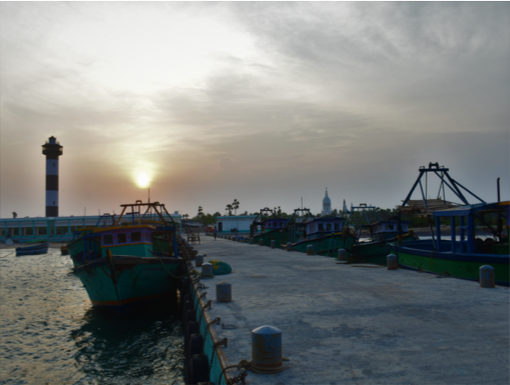
Vembar, a fishing village
Vembar is a quaint fishing village, on the border between the districts of Thoothukudi and Ramanathapuram. The belt is arid, dry, with sparse vegetation, but it is filled with warm memories, at least for me. This tiny village had a beach that was once our regular evening haunt, and we were super excited to visit the beach which we had been fairly warned about. “The old beach isn’t there anymore. They have built docking yards and so you can’t walk around much”. The Government has been constructing new fishing harbours all over south Tamil Nadu. Though the new harbours are touted as ‘development’ by the leaders, environmentalists are crying foul over state negligence towards coastal regulation zone.

We were used to long walks by the beach in the evenings and this time over, it was a walk along the wharf. Fishermen were busy mending nets in the vast halls that double up as auction centers during the early mornings. Easterly winds kept pushing the boats towards the wharf, and we could see many berthed further away, in the sea. “They rub on the wharf in tides and water gets in, at times one or two boats have had damage, and so we berth them far from the wharf”, said a fisherman when asked. We watched the orange orb drop into the sea, and drove back home.
An abandoned Portuguese church
The next morning, we had planned a trip to a nearby, small fishing hamlet called Mookaiyur. I had read a couple of days ago in the newspapers about an abandoned old Portuguese church in the village, and we started early morning. The ‘church’ stands as a magnificent two-storey high edifice, said to have been built around 1715 CE. A mutual friend from Vembar, a teacher by name Christu Gnana Valluvan, gave us a contact of a person who could tell us more about the church. Glittus is a retired vice principal residing in the fishing hamlet. As I stood clicking pictures of the exterior of the church, with its Portuguese columns and design, Glittus showed up, and was enthusiastic in showing us around the crumbling church.
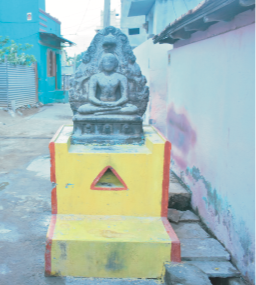
The church was built by the local people, with directions from the Portuguese, who were their allies during the initial period of European intervention in South Tamil Nadu. There are written records of Father Francis Vaiz performing mission work in Mookaiyur during 1708, in the book Arch Diocese of Madurai- Origin and Development”. There is another historical reference that the old church was demolished in 1713 CE under orders of Kizhavan Sethupathi, the King of Ramnad, who was opposed to spread of Christianity. The new church was built in 1714 and consecrated in 1715.
The village had people belonging to the fishing community, the Paravas, who sided with the Portuguese under Captain Joe Flores and fought the 14 Years War from 1528, against the Mohammadens. The main contention was rights for pearl fishing, the Paravas being expert divers, they were working under the Moors/Mohamadens along the coast from Kizhakkarai to Kayalpatnam. The Portuguese emerged victors and so were the Paravas, who en-masse converted to Roman Catholic rite of Christianity.

The church has humongous arches and fine plastering work along the lintel. There are representations of fishes everywhere – on the main altar, the pedestal. It is astonishing to see the fine workmanship when there was no cement or concrete! The entire structure is supported by arches and turrets. The lime plaster had worn out and come off in some places, and hence the fear that the structure might fall any time. Beneath all the crumbling mortar, stands a fearless deity raising his sword, mounted on a white horse. Santiago Matamoros or St. James the Moor-slayer stands in the rot, shining in his armor. The connect of a Spanish Saint to a tiny Tamil fishing village baffled me. Apostle James miraculously appeared in the legendary Battle of Clavijo, helping the Christians against the Muslim Moors, said to have happened between 5th century CE and 10th century CE, in Spain.
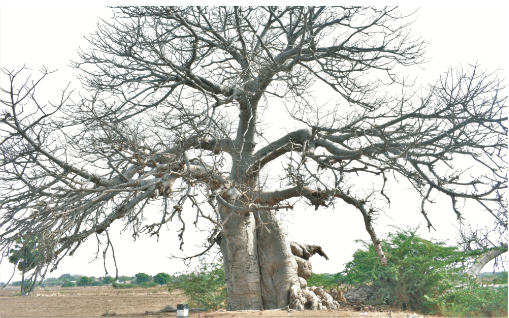
The cult of Santiago spread to the neighbouring Portugal, and through them to the fishing hamlet in Tamil Nadu. The Tamils used to their worship of guardian deity “Ayyanar” on horseback, took to Santiago on horseback easily! The 300-year-old church has been abandoned and left to rot, simply because the Parish priest there thought it was cheaper to construct a new church than repair and renovate the old one! I am not sure if I would ever see the church again, and with heavy hearts, we bid our goodbyes to Glittus. Our next search was for a tree!
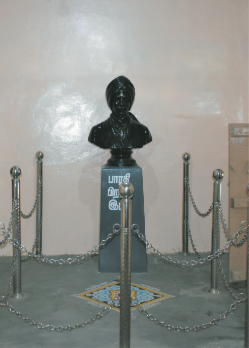
The search for the mighty baobob
The mighty baobob trees are endemic to Africa, and have a peculiar upside-down shape. But they have been reported all across India, mostly in West Indian states like Gujarat and Maharashtr,a and also along the Ganges and Yamuna rivers. They are also found along the Pearl fishing coast of Tamil Nadu. We stopped at a place called Melmanthai, a few kilometers from Vembar, and enquired about the tree. I was skeptical that a villager would know about the tree, but the moment we enquired with an elderly man about ‘pappara puli’ tree, he started directing us with earnest eagerness. The giant tree stood barren, with no signs of life in a vast tract of equally barren land. There were a few palmyra trees though, a dash of green to the eerie blackness around. Adansonia digitata can grow up to a height of 20 to 80 feet, and can have a girth of about 30 to 40 feet! These are also called monkey bread trees, as monkeys are quite fond of the fruits, that when burst open look like bread! The tree can save up to 1.5 lakh gallons of water in its trunk. Said to have anti-pyretic properties, the fruits of these trees have been eaten and its juice used as a syrup to treat chest and lung infections.
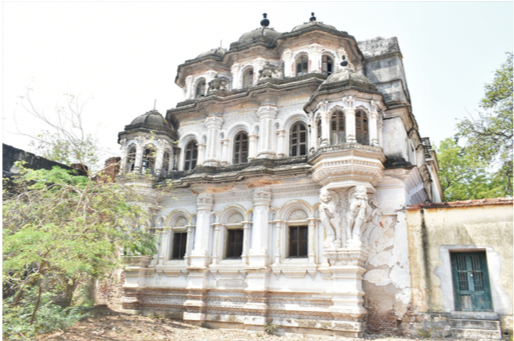
Probably it was this property that brought these trees from Africa to India. The African labourers working for their Portuguese masters had treated their liver/lung ailments with this juice, and it is said the Portuguese, or the African labourers might have brought these trees here. However, the oldest such tree in India is at Golconda Fort, and it is about 430 years old! We couldn’t ascertain the exact age of this tree that stood desolate, but we were happy to see a few leaf buds along the dry branches. Hopefully the tree must have sprung back to life by now. After a swift lunch and a short nap, we headed to Thoothukudi where we had planned to stay the night. Right on the route to Thoothukudi is Kulathur, another small village where I had seen the yellow Jain board.
The Jain boards, and a palace
Anyone touring parts of Tamil Nadu must have seen the bright yellow board placed on roadsides, mentioning proximity to Jain heritage sites. The Madurai Jain Heritage Centre has done this commendable job of marking important Jain sites in the state. We roamed a little bit in the village looking for the next sign board, and found one bang in front of the Government School. When asked, we were directed into the dusty by-lanes. “Oh! you are looking for the Buddha?” the curious onlookers commented as we asked for directions. Finally, I spotted Him seated in the middle of a narrow street. He had no roof and protection from the sun and the rains. Yet, he was seated majestically on Padma Peetah. The Simha Lanchana shows him as Mahavira. He sits with his eyes closed in Ardha Paryankasana posture, arms placed over his lap, the Chamardaris flanking him on either side with their fans. A small crowd of women gathered around me and bombarded me with questions.
“Can we worship him? Is it safe? Why is his face defaced? How do we worship him?” I tried to answer them patiently on the religious politics of how Jainism and Buddhism waned due to the onslaught of Saivism in the state, and they seemed to understand. Most Jain images in Tamil Nadu are excavated from near water bodies, with their faces smashed or bodies mutilated, the effect of royal interference in religious affairs. We reached Thoothukudi to a warm home, the city’s famed ‘poricha parottas’ and ‘pichi pota chicken’ (shredded chicken).
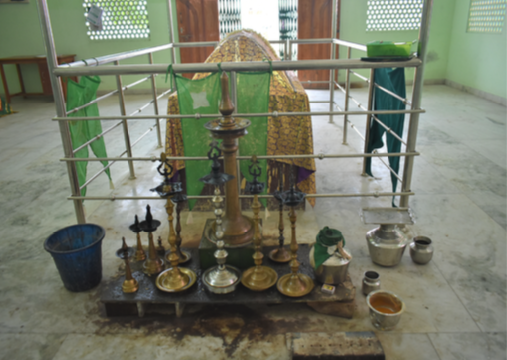
The next morning, we travelled towards Ettayapuram, a town which was once the capital of Ettayapuram Zamin. We first reached the humble abode of Mahakavi Bharathiyar, the famed poet who wrote fiery verses, spearheading the literary attack against the British during India’s freedom struggle. A tiny door at the entrance led to the room where the poet was born. There are manuscripts he wrote in English and Tamil, on display, along with a few worldly possessions like his walking stick. The old house is being maintained in a pristine condition, the antiques sparkling. There were also pictures of the poet, his Guru Sister Nivedita, his close friends Tila,k and Somasundara Barathi.
Our next stop was the dilapidated Ettayapuram Palace. Once a Zamin that had ruled the roost for a few centuries, the Zamins were great patrons of art and literature. The most notorious among them was poor Ettappa Nayak, the Zamindar who is said to have betrayed Kattabommu, the Panchalankurichi King, spilling his whereabouts to the British who were baying for his blood. The betrayal still haunts the Zamin, the Zamindari Act imposed having left him in penury. Even now, betrayal in Tamil society is addressed with the anecdote “ettappan mathri” (like Ettappan). The ‘palace’ cannot be accessed, and so we had to settle for a look at the exterior. The exquisitely carved window panels, ornate pillars, the mythical ‘yazhi’ figures carved on them, the fine lime mortar flowers and leaves etched on the walls, is proof enough of a grand splendour that was once the Zamin.
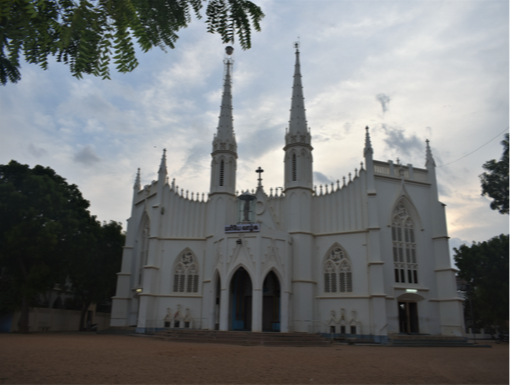
Next to the palace was the abandoned stables where there is a lone chariot placed. The entrance to this was through a small moat that was probably constructed to contain the horses. Just at the entrance were two nondescript plaques in English and Tamil, erected to commemorate the construction of a bridge across Chitra Nadi river at Gangaikondan, a town that was once part of the Zamin. Interestingly the plaque mentions the bridge was constructed with private money of the same Ettappa Zamin! The execution of construction was by the famed British Engineer Lt. W.H. Horsley, on whom the Horsley Hills of Andhra Pradesh are named!
Our next stop was Islamic poet Umaru Pulavar’s Mani Mandapam, his burial place. Umaru goes by the citation “Amudha Kavi”, meaning his poems are as sweet as ambrosia! He lived in the 16th century CE in Ettayapuram, his seminal work being Seera Puranam, the Tamil epic depicting the life of Prophet Muhammad (Sal). The place is maintained by Muslims living nearby, who light the “kuthu vilakku” Tamil lamps. The State Government built a memorial called “Mani Mandapam”, which is maintained well. They also say the annual “Sandhana Koodu” – the Urs festival is celebrated for the poet during his birth month.
A church that St. Francis Xavier visited
Our travel took us to the Our Lady of Assumption Church in Kamanaickenpatti, about 30 km away from Ettayapuram. It is said that St. Francis Xavier visited this village in 1544 CE. This is one Church that has seen the most popular European Tamil scholars like Roberto De Nobili and martyr John De Britto in 17th Century CE, Veeramamunivar @ Constantine Beschi in 18th Century CE, serve as priests. The church itself was constructed in 1679, when John De Britto converted people of this village. The large teakwood cars of this church were built by Veeramamunivar. It was at this very church that he also wrote the epic Thembavani and his Paramarta Guru fables. The church is a magnificent piece of architecture, with multiple arches and high ceiling. The Mother is decorated typically in Tamil style, sporting earrings, lots of jewelry, and donning a silk saree!
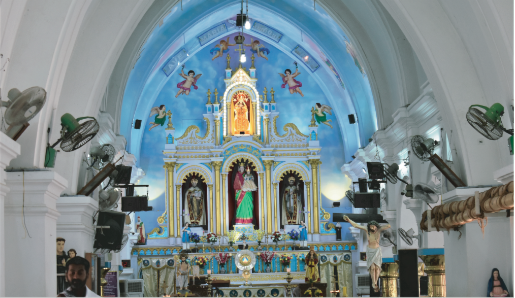
We had a quiet lunch at Tirunelveli and headed to the last stop of our trip – Vadakkankulam Holy Family Church. Called the “Trouser Church” and resembling the shape of half trousers, with two diagonal wings, this church was constructed in 1872 CE. The caste dispute of this village which led to the shape where one caste need not see the other, made headlines in 1916 CE, when the caste Vellalas sued the Bishop and Adi-Catholics, demanding separate entrances be maintained for the different castes. The case was decided against the segregation by local court and appeal in Madras High Court upheld the same. The wall segregating the castes was pulled down earlier, and the case was lodged to challenge breaking the untouchability wall in the church!
The old church, built in typical Dravidian style during 1779 CE, with stone pillars and carvings, houses possessions of martyr Devasahayam, who was killed for professing Christian faith. His belongings are preserved in this old church and displayed. It is widely believed that the statue of Mary kept in the old church opened its arms and shed tears in 1803 CE. The exterior of the old church is however a mix of Gothic and Dravidian architecture. I could climb up the church and see the curved roof and tiles stuck on it.
The trip was short, and I was sad it was over too soon. But it was indeed a refreshing and eye-opening trip, as I could see the multi-cultural Tamil society seeped in religious plurality. That is the essence of our country- a sovereign, socialist, secular, democratic republic!

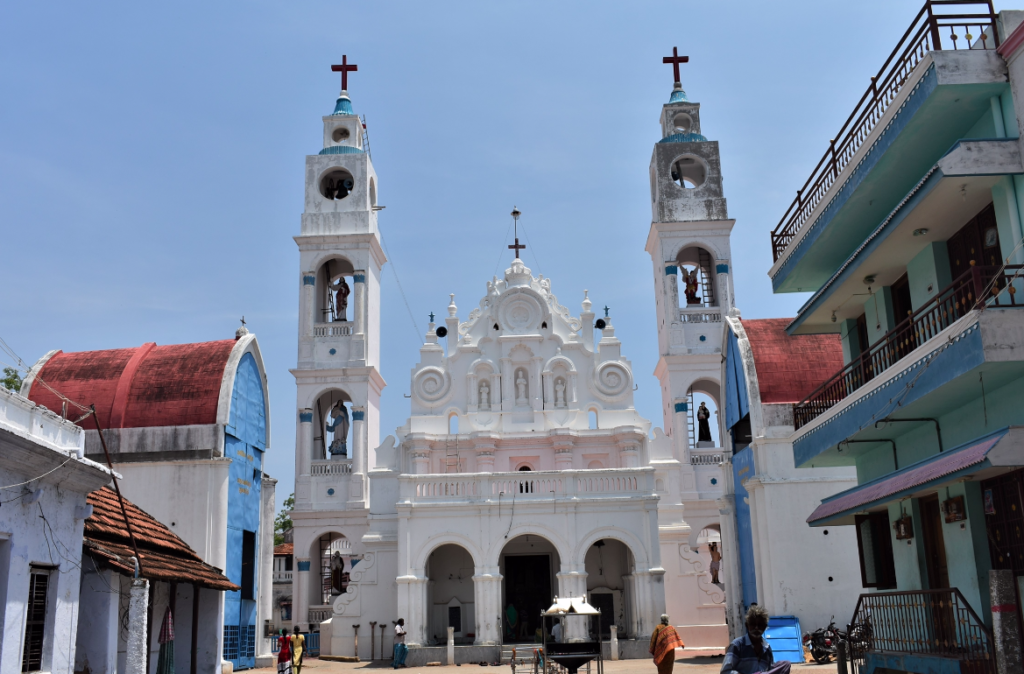
 [/column]
[/column]